Adley Rutschman and the Difficult Journey Facing MLB's Next Generational Catcher
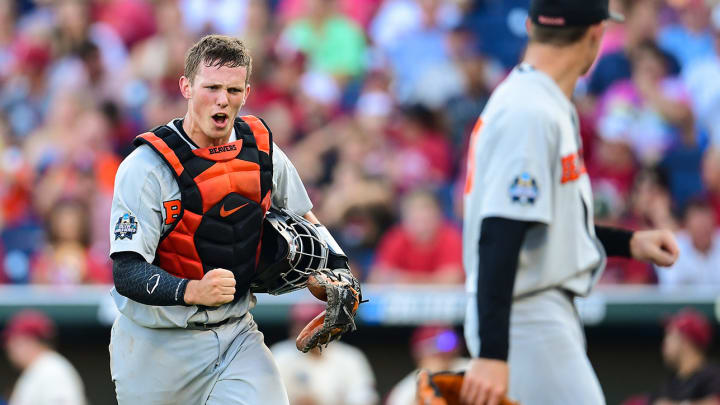
In the 18 years since the Twins turned high school catcher Joe Mauer into the No. 1 pick of the 2001 MLB draft and a Hall of Fame presence behind the plate, every other team in baseball has tried its hardest to find similar gold in the first round. Fifty different players over that span have been selected from across the country, all with the hopes that they, too, could be a franchise’s backstop of the future.
For the most part, they’ve all failed.
With the exception of Buster Posey in 2008, the highly touted catchers drafted this millennium make for a long list of has-beens and never-weres. There are the would-be superstars like Matt Wieters and Mike Zunino who didn’t live up to the hype. There are guys like Devin Mesoraco, Travis d’Arnaud, and Blake Swihart who went from top prospect to roster filler. And there are the big busts: Jeff Clement, Kyle Skipworth, Tony Sanchez—the names that keep general managers and scouts awake at night.
No catcher has been picked first overall since Mauer in 2001, and he was only the fourth ever and the first in 26 years. (Georgia Tech’s Joey Bart was the closest since, going No. 2 last year to the Giants.) Not that things are much better at any other spot: Just 16 of the 146 first-round catchers ever drafted have been worth 20 or more Wins Above Replacement in their career, and nearly half of them, like Craig Biggio and Dale Murphy, produced most of that value at other positions. The draft is a brutally hard thing to figure, but no position seems tougher to predict than catcher.
Next Monday, though, one team will get the best shot in a decade to solve that problem. In all likelihood, when Commissioner Rob Manfred steps to the podium in the Secaucus, N.J., studios of MLB Network that night to announce the No. 1 pick of the 2019 draft, the name he’ll read aloud is Adley Rutschman, a switch-hitting catcher for Oregon State and the next great hope to join the ranks of Mauer and Posey.
Both the 2019 Pac-12 Player of the Year and a finalist for the Golden Spikes Award, Rutschman has spent the last two years torching NCAA competition. As a sophomore in 2018, he hit a preposterous .408/.505/.628 with nine homers and 22 doubles, helping the Beavers win the College World Series as its Most Outstanding Player. He’s been even better in his junior season, slashing .419/.580/.765 with 17 homers and twice as many walks as strikeouts, making him a regular name atop mock drafts and the favorite to go No. 1.
“Rutschman has the chance to be a generational talent,” says a Northwest area scout. “If he doesn’t go [No. 1], I’d be shocked.” Adds an MLB scouting director: “Everything I’ve heard is that he’s on par with Posey in overall long-term profile.”
The praise from those close to him is just as high. “So many people have asked me, if you had one negative thing to say about him, what would it be? I always tell them, nothing,” says Oregon State head coach Pat Bailey. “There are a lot of really good players, but this guy's going to be a game-changer.”
Whether Rutschman follows in Mauer’s footsteps as the top overall pick is in the hands of the Orioles, who haven’t said publicly what they plan on doing with the team’s first No. 1 selection since 1989. But whether it’s Baltimore or Kansas City at No. 2 or perhaps the White Sox at No. 3, one way or another, Rutschman will be drafted high. And after the congratulatory phone call and the hugs with family and the signing of the first big contract, then he will begin the process that has stalled or destroyed so many other prospects of his stature: becoming a big league catcher.
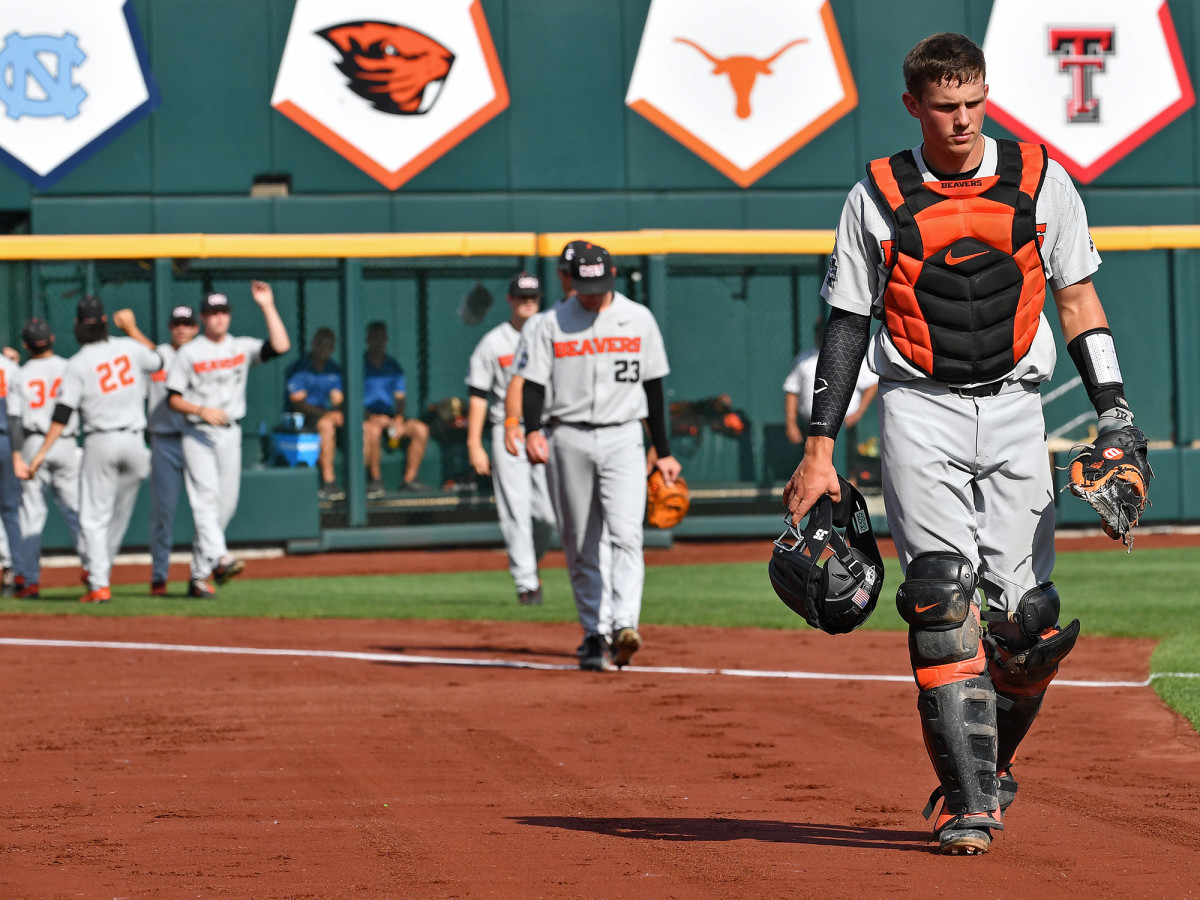
It’s no secret: catching is the hardest position in baseball. “It’s probably one of the hardest positions in sports,” says veteran Dodgers catcher Russell Martin.
The elite at the position, then, are those who combine All-Star–caliber hitting with Gold Glove-level defense. Posey, Mauer, Yadier Molina: Those are the names fellow catchers put at the top of the ziggurat. They’re incredibly rare—the closest thing baseball has to platinum. And one who can stick at the position long-term is a true unicorn. “If you can find one of those guys that can hang around for 10 years with the same team, those guys change franchises,” says Reds catcher Curt Casali .
The trick, though, is finding that guy. They’re rarely available via trade and command a fortune in free agency. Your best hope is to draft and develop one, but that’s where the problems begin. Being good enough defensively to play in the majors is already a tough bar to clear; being above average offensively on top of that proves to be a challenge too hard for most. That’s true of the blue-chippers and longshots alike.
So how do you turn a catcher with a first-round pedigree into a major league star? In Rutschman, whichever team picks him may have a prospect who’s simply too good to fail.
Bailey has been a close friend of the Rutschman family for years. He coached baseball alongside Randy, Adley’s father, at George Fox University and has known Adley since he was five. Both Randy and his father, Ad, played baseball and Adley took up the sport at the same position his father played: catcher. As such, Bailey kept up with Adley’s development. By the time Adley reached his sophomore year of high school, Bailey was pitching him to play at Oregon State, where he was an assistant coach. Getting Adley to commit was a slow process, so Bailey decided to get drastic.
“At the beginning of his junior year, I had [Adley’s parents] call me,” Bailey says. “I said, if Adley doesn't commit to me within the next two weeks, I'm going to burn your house down. They started laughing, and I said, I'm not joking.”
Bailey wasn’t serious, though given what Adley has done since joining him in Corvallis, arson apparently would have been justifiable. Thrust into a starter’s role from day one, Rutschman has become arguably the country’s top college hitter. “The overall package of him as not just a baseball player but also as a human being is off the charts,” Bailey says. “I've been coaching for 41 years, and I don't know if I've had an individual as wonderful as Adley is.”
It’s not bad for someone who says he didn’t enjoy catching until he turned 16 and was initially supposed to pitch at Oregon State, and who his father says wasn’t even all that into baseball at a young age. “If you gave him a choice between watching the World Series and being outside playing, he'd be outside playing,” Randy says. Regardless, Adley loved the sport. His childhood bedroom, Randy recalls, was bedecked in all things baseball: a dresser with knobs painted white with red stitches; a Cardinals blanket on the bed, in honor of his favorite player at the time, Albert Pujols; baseball bats and gloves everywhere. By the age of eight, Adley says, he knew he wanted to be a major leaguer.
Adley first started catching in third grade, though as a child he played multiple positions. Randy was a highly regarded catching coach—“I think he’s one of the best in the country,” Bailey says—so it was more likely than not that his son would find himself behind the plate for good. It was Adley’s choice, though, to stick with it. “He never pushed catching on me, which was cool, because now it's because I wanted to do it instead of something he wanted me to do,” he says of his father. “He made it fun for me.”
To help develop those skills, Randy put his son up against high-level competition. As a sophomore in high school, Adley says his dad would have him catch college and professional pitchers in the area. “It was trying to get me to be comfortable being uncomfortable,” he says. “In high school, you're catching guys who're throwing 80 [mph], so trying to catch a guy with 92 and sink was hard. I was like, I don't know if I want to catch those guys. But as I got to do it more, it was one of those things I looked forward to, because then you go back and catch high school guys and it's like, wow, this makes it a lot easier.” It helped that, his junior year, Adley, a self-described late developer, added six inches and 40 pounds to his frame. (He now measures 6’2” and 216 pounds.)
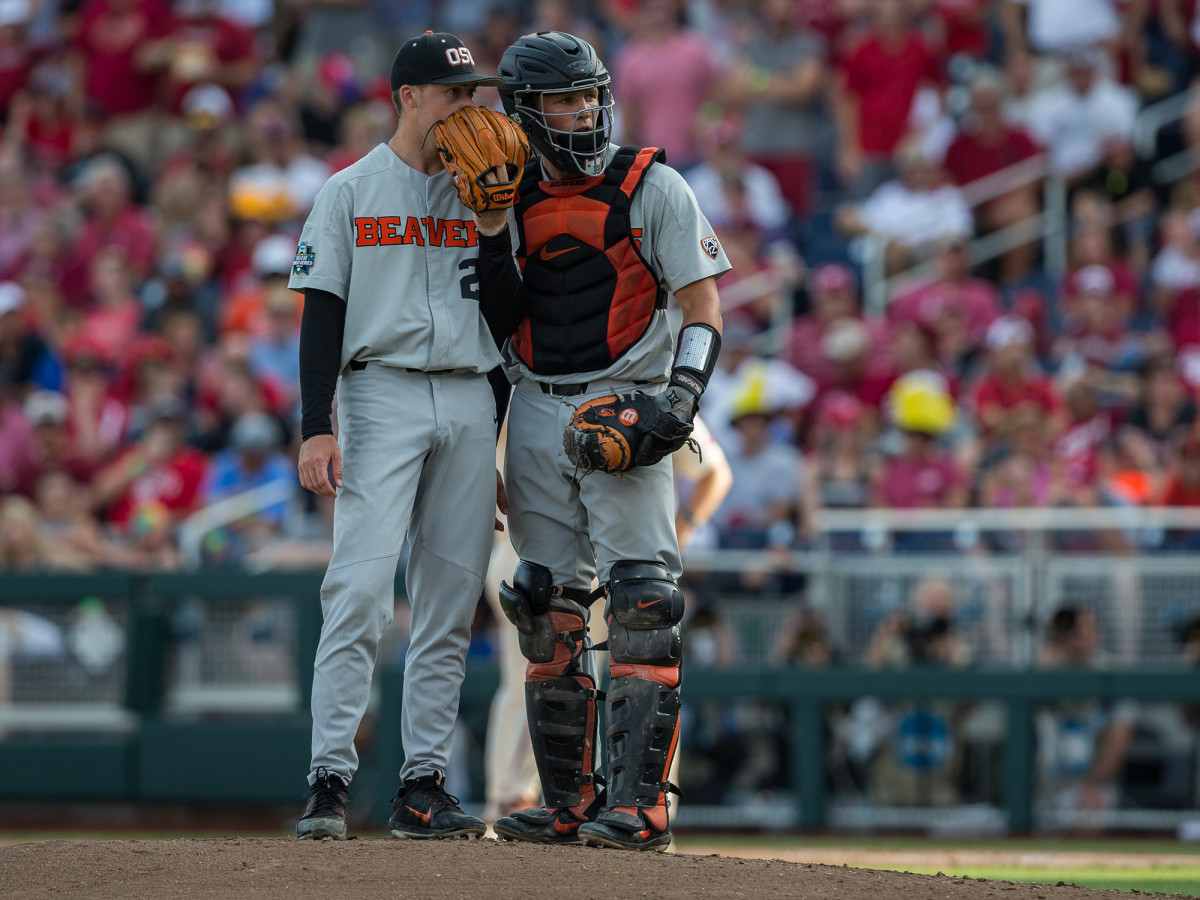
Aside from catching, Rutschman pitched at Sherwood High (Ore.), throwing as hard as 93 mph as a sophomore. (He was also a kicker on the football team and played the sport his freshman year at Oregon State.) MLB teams, though, were interested in him as a catcher; the Mariners tried to take him in the 40th round of the 2016 draft. He turned them down to attend Oregon State, where his pitching career was shelved.
Although Rutschman hit just .234 as a freshman, Bailey wasn’t worried. If nothing else, Adley was an excellent defender, and he figured the offense would come around in time. It didn't take long. He broke the school’s single-season records for hits and RBIs as a sophomore and then set the College World Series record for total hits. In the championship-clinching game against Arkansas, he went 3-for-4 and drove in two. This season, he’s put up gargantuan numbers despite teams refusing to pitch to him: His 73 walks (in 55 games) lead Division I.
Even if Rutschman weren’t hitting that well, his defense alone would make him major league caliber. Bailey has Rutschman’s pop time—the amount of time it takes to catch a ball, get out of a crouch and throw to second—clocked between 1.9 and two seconds, which would place him firmly in the top half of all MLB catchers. Scouts marvel at his ability to steal strikes and block balls in the dirt despite his large frame. And though he doesn’t call all the pitches—few college catchers do—Bailey and his coaching staff are more than comfortable letting him. “There's times when [pitching coach] Nate [Yeskie]’s not sure what to do, so he points at him and tells him to do it,” Bailey says.
It’s clear that Rutschman is special, and in more ways than one. Asked to pick a favorite Rutschman moment, Bailey hesitates. “All the game-winning hits,” he finally says—as in, several. “It’s crazy how many he has,” he adds, before landing on the best.
“We're up at Washington this year. Bases are loaded, two outs, we're up by one. Nate looks at me and goes, I'd walk him right here. I said, you're going to walk him in the seventh inning to go down two runs? I'm not, I'm pitching to him. Two pitches later, he doubles to the wall to clear the bases. Nate looked at me and goes, see, I told you, I would've walked him.”
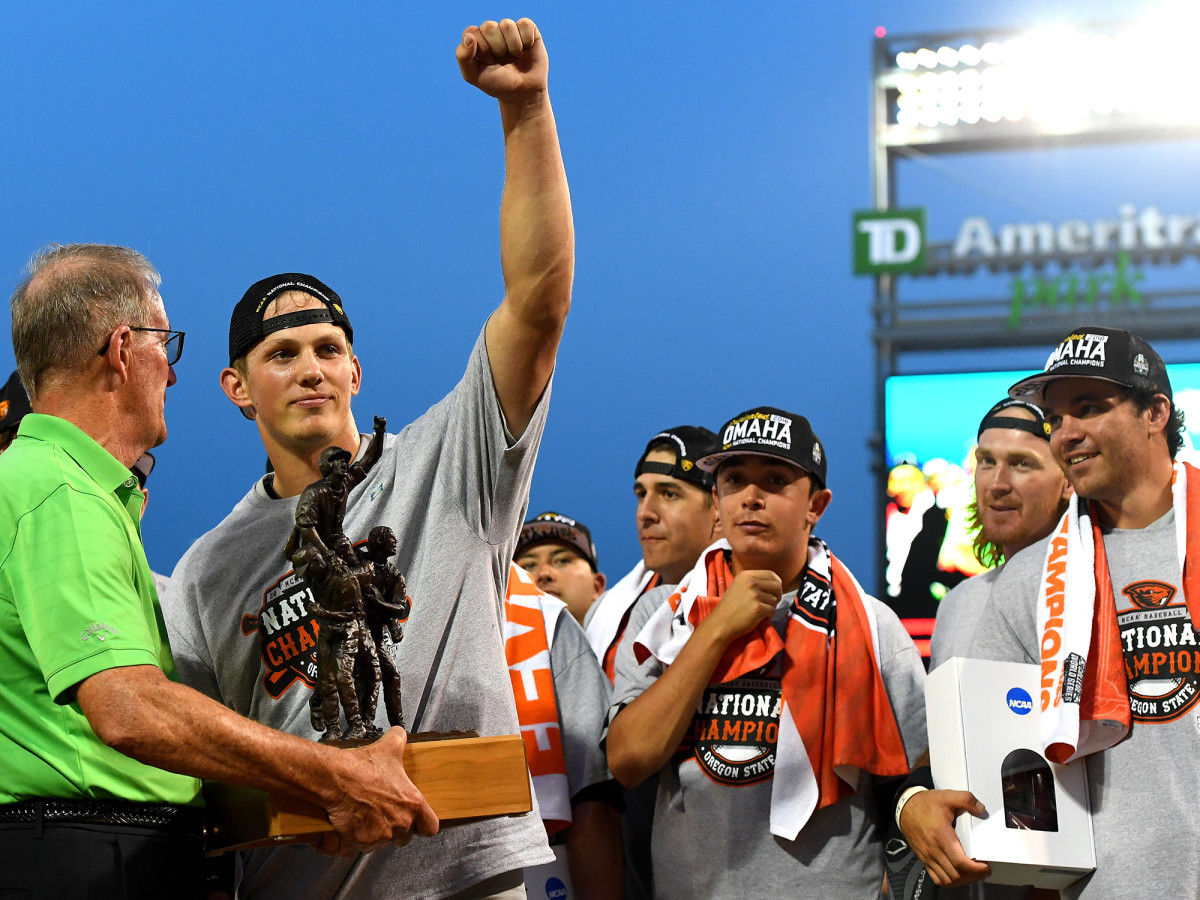
All of that seemingly adds up to a player that most general managers would pick without a second thought. If that’s how Orioles general manager Mike Elias feels, though, he’s keeping that to himself. “We always leave the decision to the day of the draft, because there's so much information that can come in late,” he says when asked if Baltimore has made up its mind on No. 1. “At this time, we've got five players we're actively considering, and we're keeping our eye on one or two other dark horses.”
Rutschman is almost certainly one of those five, though Elias won’t discuss him or anyone else specifically. The other likely options include Texas high school shortstop Bobby Witt Jr. (son of former big leaguer Bobby Sr. and whose uncle, Doug, is an Orioles scout), University of California first baseman Andrew Vaughn, and Georgia high school shortstop C.J. Abrams.
Who the Orioles choose will come down to a bevy of factors, with signability a big one. That’s part of what guided the choice of Carlos Correa by the Astros at No. 1 in 2012; Elias was Houston’s scouting director at the time and is credited as pushing for that selection. Picking Correa, a surprise selection from a Puerto Rico high school, helped save the Astros money, as his signing bonus was under-slot, freeing up cash for more expensive picks like Lance McCullers Jr. and Rio Ruiz.
“We want to monetize this opportunity we've been given, so we're looking for the best investment, and that might not be the one with the most extreme superstar upside,” Elias says.
In choosing Correa, the Astros bypassed, among others, Zunino, a catcher out of Florida who had won both the Golden Spikes and the Johnny Bench Award as the nation’s top collegiate backstop. Zunino ended up going third overall to the Mariners, for whom he hit .207/.276/.406 over six seasons before being traded to the Rays last winter.
The risk with taking Rutschman at No. 1 is that he ends up more Zunino than Mauer. Or he could be a carbon copy of the last catcher the Orioles put their faith into: Wieters. The No. 5 pick of the 2007 draft, he was hailed as the next Bench. “His teammates at Georgia Tech called him, simply, God,” wrote SI’s Tom Verducci in 2010. Yet while he made four All-Star teams and won two Gold Gloves in Baltimore, Wieters never joined the pantheon of greats, hitting just .256/.318/.421 across eight years with the O’s. (He’s now the backup to Molina in St. Louis.) Even the can’t-miss catchers seem to end up far short of their potential more often than not.
“When you take a catcher, there's just a lot more that needs to go right for him to do well, and it's demanding and difficult,” Elias says. “But you need catchers, so people use high picks on them despite the fact that maybe it's a more rigorous path forward than other positions.”
Therein lies the Catch-22 of catchers. Take one high in the draft, and you might burn a precious top pick on a player who, because of the difficulty of the position, never pans out. But turning down a chance at a potential Mauer-level talent at arguably the hardest spot to fill on the roster is hard to do. “Personally, I’m surprised more catchers don’t go that early,” Randy Rutschman says.
Figuring out that risk-reward calculus is hard, and Elias has no solution for it—or at least, none he cares to divulge. “If I had an answer to that, I wouldn’t share it with Sports Illustrated,” he says with a laugh. But it’s a dilemma he’ll have to crack between now and 7 p.m. ET on June 3, when the clock will begin ticking on the Orioles’ pick and he and Baltimore’s braintrust have to make the decision that will help determine the future of a woebegone franchise trying to right itself.
“In terms of picking the absolute very best player out of the draft, that's almost never happened,” Elias says. “So to some degree, you're just trying to come away with a really good pick.”
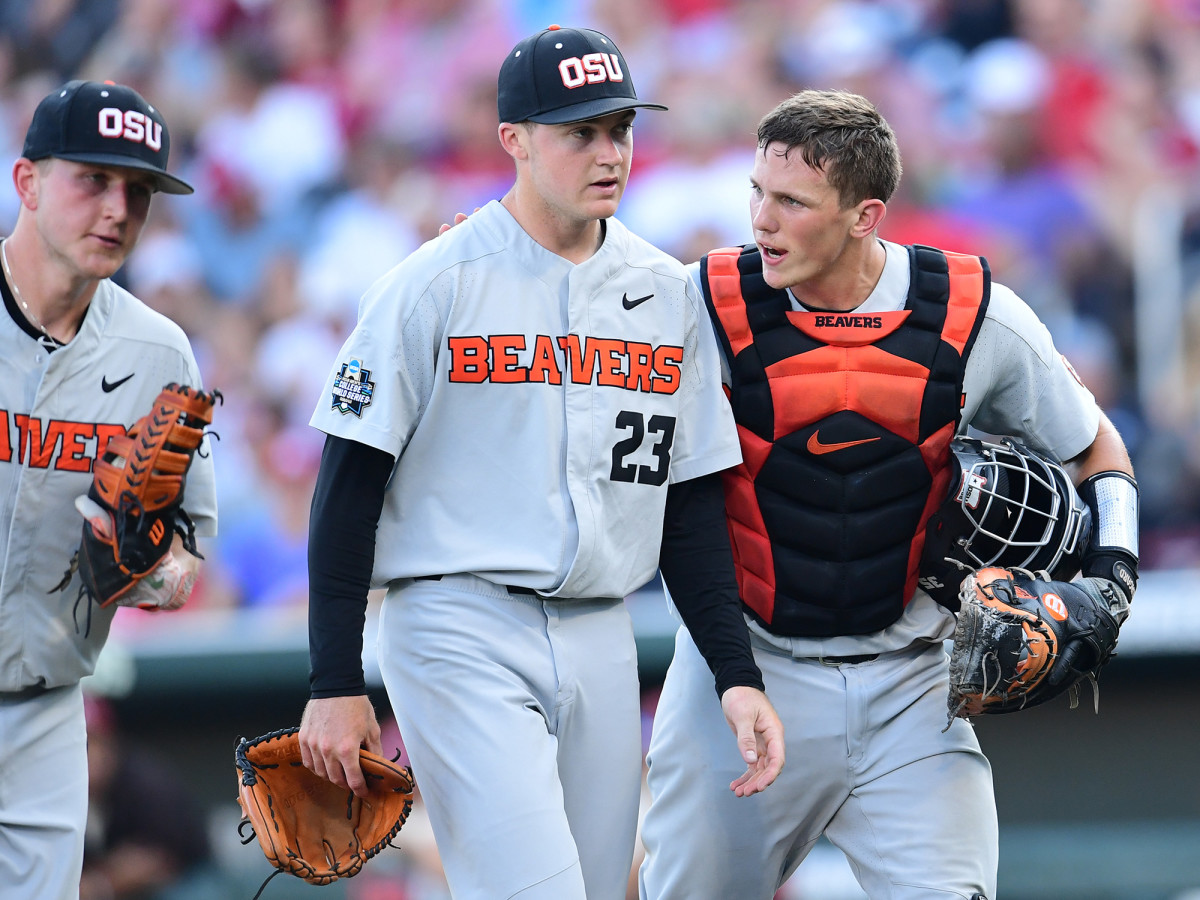
Asked whether he cares about being the No. 1 pick, Rutschman says yes, though only to a certain degree. “It's one of those things where I'd want it, just because it'd be a tribute to how hard I've worked in the process that I've gone through,” he says. “It doesn't really matter as far as the ego standpoint goes.”
“I think he wants to be in a situation where he's going to be valued, whether that's Baltimore, the Royals, the White Sox,” Randy says. “I don't think [No. 1] really matters.”
Regardless of which team is on the other line, at some point Monday night, Rutschman’s phone will ring as he watches the draft with friends and family in Corvallis, and a major league GM will welcome him to a new squad. If he goes first overall, he’ll make for a neat piece of trivia, but either way, the pressure will be on him right away to succeed where Zunino, Wieters and countless others couldn’t. Those close to Rutschman don’t worry about that burden being too heavy. “I can tell you right now, failure for him will be his teacher,” Bailey says. “He'll persevere through anything.”
If he can survive the rigors of the position, he could be part of arguably the most elite and rare group of players in the game itself. Already, though, as someone who chooses to strap on the gear and play the position, he’s part of a unique club all its own.
“It takes a certain breed,” says Russell Martin, before adding with a smile, “You almost pride yourself in that.”
